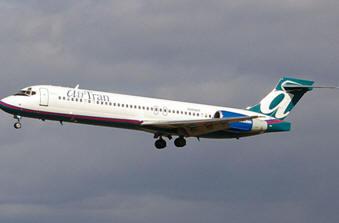|
|||||||||||||||||
|
|
|
|||
|
By |
||||
 |
February 25, 2011 - The Federal Aviation Administration
(FAA) informed Southwest Airlines that it has accepted
the carrier's transition plan to combine the operations
of Dallas-based Southwest Airlines and Orlando-based
AirTran Airways, following the financial close of its
transaction to acquire AirTran.
On Sept. 27, 2010, Southwest announced an agreement to acquire all outstanding shares of common stock of AirTran Holdings, Inc., the parent company of AirTran Airways (AirTran), for a combination of cash and Southwest Airlines' common stock. Closing is subject to the approval of AirTran shareholders, receipt of certain regulatory clearances, and fulfillment of customary closing conditions. |
|||
|
"It's been a great team effort by a lot of people to reach this initial milestone, but we still have a lot of work to do to ultimately bring our two carriers together. We appreciate the collaborative approach of all parties, including the FAA Joint Transition Team (JTT)," said Brian Hirshman, Southwest's Vice President Maintenance and Engineering, and Executive Sponsor of the carrier's Single Operating Certificate (SOC) team. "We consider this acceptance by the FAA as the first major milestone on the journey towards SOC. There are too many people to recognize individually, but we are hopeful the team's hard work will allow us to achieve our SOC goal in the first quarter 2012." Southwest and AirTran currently have separate operating certificates. The transition plan accepted by the FAA outlines the methodology, processes, tools, and timing to be employed to maintain the safety of their day-to-day operations during the transition period and to ultimately achieve a Single Operating Certificate. The SOC is issued by the FAA once all of the steps outlined in the transition plan have been completed. The carriers' processes, and procedures may not be fully integrated when the SOC is issued, however; they will operate under a single FAA certificate at that time.
Relevant
to its submitted plan, Southwest clarified that after the
transaction close, which is currently anticipated to occur
during the second quarter of 2011, all certificated and
flight-related AirTran Employees (Pilots, Dispatchers, Flight
Attendants, Mechanics, Schedulers, etc.) will maintain their
AirTran employment status at least until the SOC is issued by
the FAA for the combined carriers. The logistics of how and when
this group of certificated employees will then be transitioned
to Southwest employment status has yet to be determined. |
||||
|
Southwest Airlines
is the nation's largest carrier in terms of originating domestic
passengers boarded, now serving 69 cities in 35 states. Beginning March
13, 2011, Based in
AirTran Airways is
an American low-cost airline. A subsidiary of the Orlando-based AirTran
Holdings, AirTran operates over 1,000 daily flights, primarily in the
eastern and midwestern
AirTran Airways
traces its roots to the 1992 founding of ValuJet Airlines in In February the FAA ordered ValuJet to seek approval before adding any new aircraft or cities to its network, something the industry had not seen since deregulation in 1979. This attempt at removing ValuJet's certification was "lost in the maze at FAA" according to NTSB Chairman Jim Hall. |
|
|
| ?AvStop
Online Magazine
Contact
Us
Return To News
|
|

